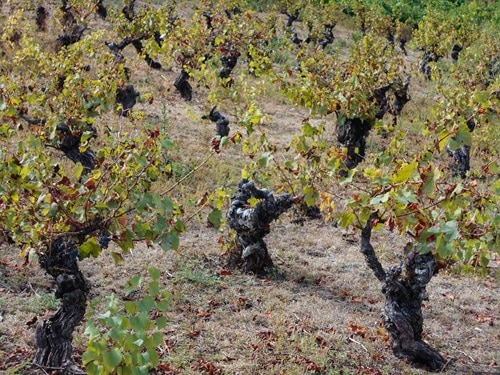Vine diseases
Vine diseases represent a constant threat to the quality and quantity of wine production, requiring increased vigilance and management on the part of winegrowers.
At the heart of the vineyard, many factors such as soil, climate and farm management practices play a crucial role in the development of vine plants. However, these same factors can also encourage the development of various diseases, such as botrytis cinerea (grey rot) and powdery mildew.
Early detection of symptoms is essential for effective vine disease management. From leaves to roots, berries to wood, every part of the plant can be affected. In this comprehensive guide, we cover the essential aspects of grapevine diseases, from identification to treatment.
Downy mildew
- Causes: Downy mildew is caused by the fungus Plasmopara viticola, and develops in damp conditions, often in spring, especially when the weather is mild and rainy.
- Symptoms: oily spots on leaves, turning into brown spots. Berries can also be affected, drying out and bursting.
- Treatment: use copper-based spray treatments such as bouillie bordelaise and prune the vines for better aeration to reduce moisture between the leaves.
Powdery mildew (White)
- Causes: a fungal disease caused by a microscopic fungus. It develops when the climate is mild and humid. Shade favors the establishment of this humidity, so it is advisable to plant the most sensitive vines in sunny areas.
- Symptoms: white powder on leaves and berries, which can lead to bunch rot.
- Treatment: spray application of sulfur and specific fungicides.
Black-Rot
- Causes: this condition is caused by a plant-pathogenic ascomycete fungus. It manifests itself mainly with the return of mild weather in spring, the fungus being active in a temperature range from 9°C to 32°C, with an ideal temperature between 20 and 26°C, and requires high humidity to develop.
- Symptoms: this pathology affects all green parts of the vine, including bunches, leaves and twigs. Leaves show symptoms of black rot in the form of brown or red spots a few millimeters in size, with small, shiny black pustules.
- Treatment:
There is no specific treatment for this disease, but treatments designed to combat mildew or powdery mildew are effective against this fungus.
Wood diseases (Esca, Eutypiosis, Black Dead Arm (BDA))
- Causes: wood diseases are caused by fungi that spread mainly through the air, taking advantage of the presence of water and high humidity conditions to infect vines. Pruning operations create wounds on vine plants, offering direct access to pathogens that settle in the wood, hindering the healthy development of the vine. A season characterized by mild temperatures (20-30°C) and abundant rainfall increases the risk of these diseases appearing and spreading.
- Symptoms: the first visible signs appear on leaves, berries and twigs in the form of spots or rot, often indicating the presence of disease. In advanced stages, internal symptoms develop in the wood of the stock, obstructing sap vessels and leading to the death of areas without sap flow, a process that can take several years to become apparent.
- Treatment: Choosing resistant grape varieties and quality plants is essential to reduce the risk of infection. Managing plant debris and eliminating diseased vines also limits sources of inoculum.
Revising pruning methods to minimize wounds and respect sap flow helps prevent pathogens from entering the vineyard.
In the event of infection, curettage and regrafting can save partially affected vines. For dead vines, uprooting and replanting are common but costly measures, with the risk of reinfection.
Excoriosis
- Causes: excoriosis is a fungal disease of grapevines caused by the fungus Phomopsis viticola. It mainly attacks young shoots at the beginning of the season, at bud-break. Rainfall and relative humidity of over 85% after bud break are essential for the development of excoriosis, favoring the release and dissemination of the fungus’ spores.
- Symptoms: the first signs of excoriosis appear as black spots, either punctiform or elongated, on young shoots, around a fortnight after budburst. The disease can extend to the leaves, showing round spots with a brown center surrounded by a light-green periphery. In the event of severe attack, these spots can dry out and cause the affected parts to fall off.

- Treatment: it is advisable to remove infected shoots when pruning and to remove them from the vineyard to reduce sources of infection. Managing grass cover and nitrogen fertilization helps to limit the development of the disease by controlling plant vigour. Two strategies are recommended for the chemical treatment of excoriosis. The first involves two applications of a contact fungicide. The second, simpler strategy is based on a single application of a fosetyl-Al fungicide at the initial “bud burst” stage.
Botrytis
- Causes: caused by the Botrytis cinerea fungus, which affects various vine organs, with a marked preference for berries. This fungus is particularly polyphagous and finds the vine an ideal host. During the winter, Botrytis cinerea can be found in leaves that have fallen to the ground or on shoots, sometimes under the bark, ready to contaminate the vine when favorable conditions return. Contamination can occur via conidia, particularly on wounds caused by bad weather or pests (grape berry moths).
- Symptoms: symptoms become particularly visible from veraison onwards, affecting all green organs, but mainly berries, where the fungus takes hold at the slightest wound. Infected shoots show brown spots that turn white after the grapes have matured, followed by the appearance of black sclerotia. On berries, this results in brown spots, and a gray felting may appear on the underside of affected leaves.
- Treatments: it is crucial to identify at-risk plots and apply appropriate management, including controlled permanent grassing and aeration of the fruit-bearing zone to limit humidity. It is important to prevent berry wounds and to control pests, in particular grape berry moths, to reduce entry points for the fungus. The application of preventive fungicides is a key strategy. Two solutions are recommended: a boscalid-based anti-botrytis and a pyrimethanil-based one, to protect vines against the appearance and development of grey rot.
Faced with the challenges posed by spring frosts, it’s crucial to adopt an innovative crop protection system. Find out more about this revolutionary solution, click here.

